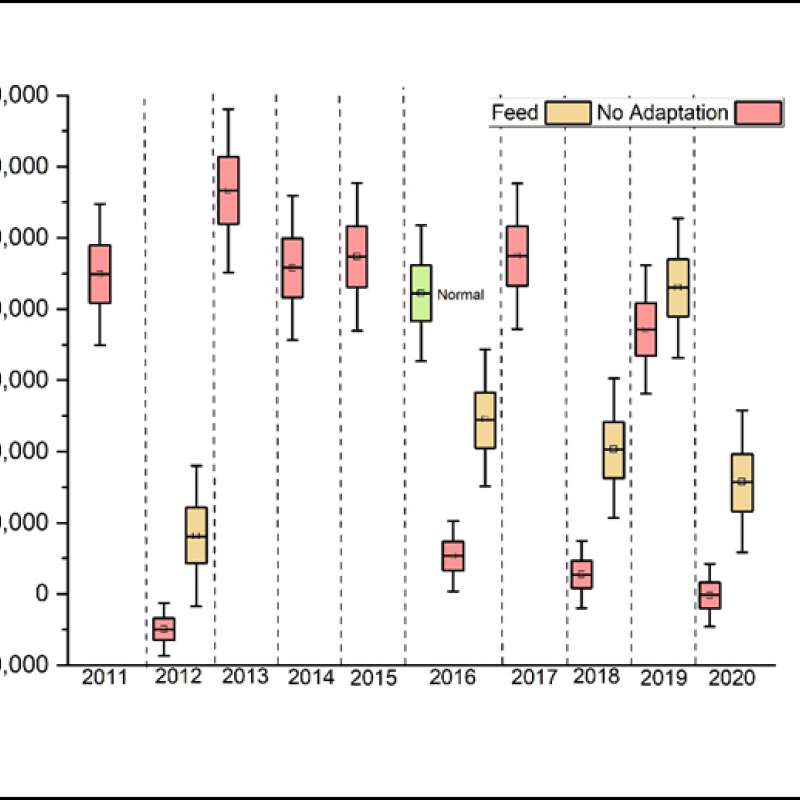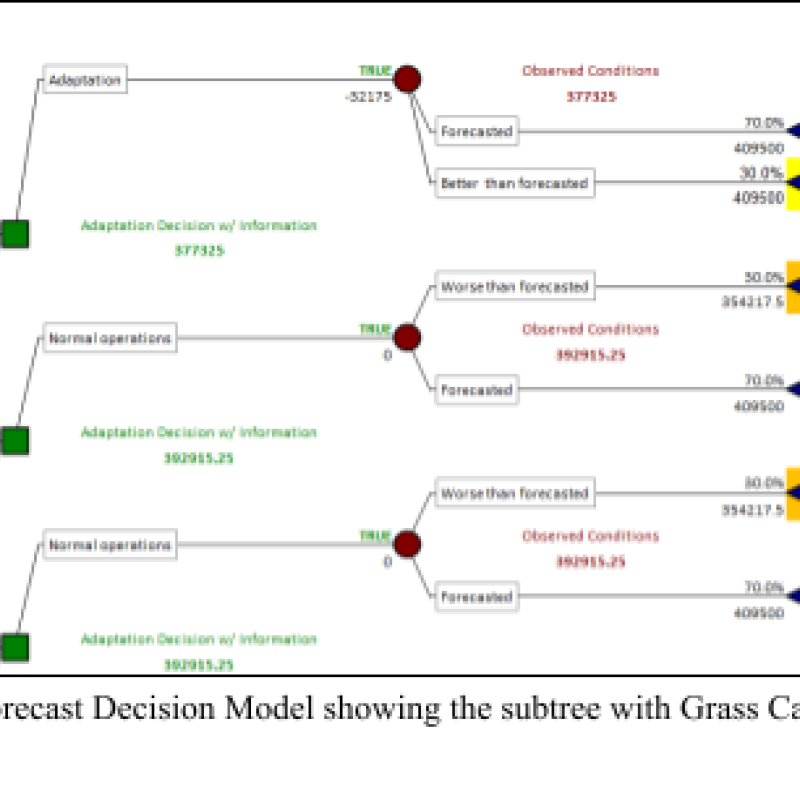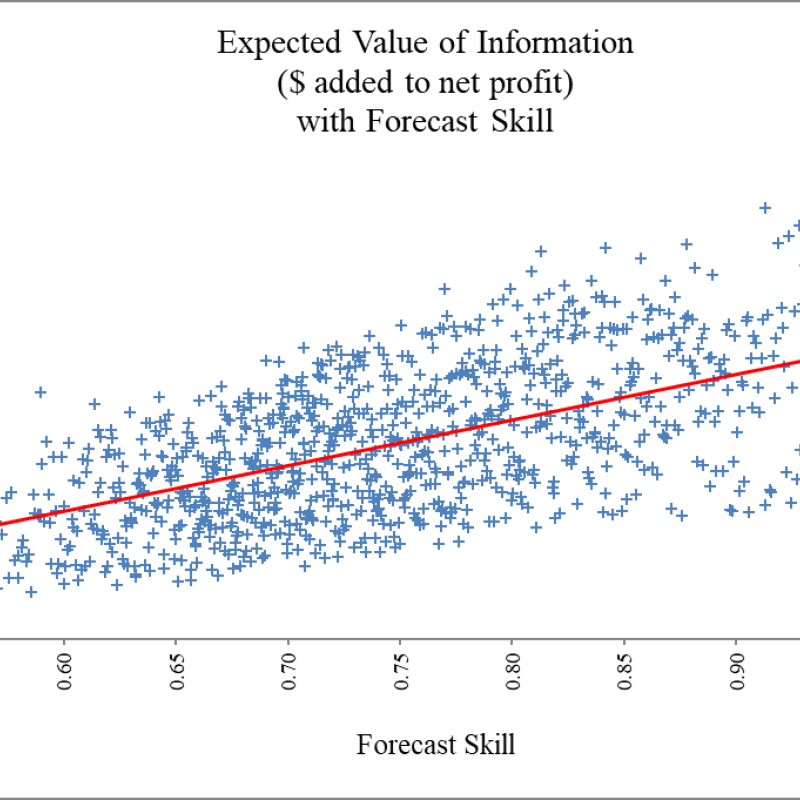Forecasting can Improve Drought Adaptation and Income on the Ranch
We developed decision-making models, utilizing forecasting tools, to prevent both under- and overadaptation by ranchers.
Ranchers across the western United States face recurrent drought that reduces forage on their ranges, cattle weight gain, and their gross and net income. Drought years have crept up from about one-out-of-five to two-out-of-five years over the last two decades in the Great Plains and Southwest. Dry years can both increase operating costs (for example by forcing ranchers to buy extra feed or rent extra pasture) and reduce income (by forcing ranchers to wean and sell cows earlier than normal, often a lower weights and occasionally in markets flooded by cattle as other ranchers in the region do the same (Figure 1).

Figure 1: Net income under actual conditions 2011-2020 for a simulated 650-head cow/calf ranch located at the Central Plains Experimental Range (CPER) near Nunn, Colorado.
The Rancher’s Risky Choice
In dry years ranchers face daunting drought decisions as was made clear in news reports during the 2011-2012 drought on the southern Great Plains that caused the largest sell-off of the nation’s cattle herd in history. Stories described the classic decision bind: a rancher is
“…..struggling to find enough grazing to feed 300 cows, plus their calves. He hopes to get by with selling only a quarter of his herd, but there are no guarantees with the drought expected to linger through October.” (Hegeman, 2012).
Ranchers bemoan the awkward cycle in which they either purchase extra feed just when prices increase due to drought-induced shortages, or cull their herds to save their pastures, selling into flooded markets at lowering prices. Culling the herd is a painful process given long-term efforts to match genetics and cattle behavior to local range conditions. Thus ranchers either maintain conservative herd sizes or hold tight in the hope that drought will abate and they can eventually market cattle near their original weight and body condition goals. As one rancher said: “If you can figure out a way to hang on to them at a reasonable cost until the drought is over, it typically pays you pretty well” (Hegeman, 2012). Holding on means finding alternative feed and pasturage options. But the urge to hold on, even as drought worsens, is often cited as a cause of long-term range ecosystem degradation (Knutson and Haigh, 2013; National Drought Mitigation Center, 2011), and much of the drought advice provided to ranchers warns against that strategy.
In the worse case ranchers may find themselves degrading range productivity, buying expensive feed, renting pasturage at inflated prices or large transportation costs and, finally, selling into a market flooded by other producers who are also culling their herds. Even worse, those forced to market more than they would have in normal circumstances find themselves paying a premium to rebuild herds in the drought’s aftermath. Ranchers who were slow to de-stock may also be slow to rebuild their herds as drought eases. In 2015, with the industry in recovery, the Wall Street Journal could still find aversion to climate risks, quoting a rancher who was waiting to expand his herd back to its pre-drought levels: “’I’m not willing to spend $2,000 or $2,500 for a bred heifer and not know if I can make a profit next year,’…... ‘I’m not sure the drought is over’” (Gee, 2015). It is no wonder that one extensive set of guides to ranch-drought management is sprinkled with suggestions for maintaining mental and physical health, and family well-being, through such tough choices.
Of course, such loss scenarios only play out if, indeed, drought continues, and decision theory as well as producers recognize that uncertainty about even near-term future conditions (Will the drought continue? Will it worsen?) means that it is only in hindsight, with knowledge that the drought did, indeed continue, that early adaptive decisions would appear justified. The producer who chooses no action in the early stages of drought may well be wise, especially since most dry spells do not become extreme droughts.
More and better drought information could help.
Ranchers use a variety of strategies to deal with this drought decision bind, drawing no their experience, advice from agricultural professionals, maybe putting off bigger adaptations hoping the drought will abate, or at least “next year” will be better. But in the end they all have to make choices.
Better information can help, as can better decision analysis. So we brought together a new forage prediction tool, Grass Cast (https://grasscast.unl.edu/ ), with formal decision analysis, to see if we could calculate the added value that information could provide a ranch operation.
The Forecast Decision Model
The decision model uses decision trees to simulate ranchers’ responses to forecast conditions. It simulates three main information use and adaptation scenarios (Figure 2):
- An early season check-in that can result in a one-time adaptation choice for the remainder of the grazing season;
- A sequential check-and-decide process that allows decision up-dating over the season as new information becomes available, and provides multiple potential adaptation pathways; subsequent decisions are affected by previous choices and by the passage of time whereby some choices are foreclosed and some adaptations becomes less effective and/or incur different (typically increased) costs; and
- A multiple-input decision, using the seasonal forecast and Grass-Cast, but also checking the USDM to assess the extent and severity of local and regional drought.

We include two main types of adaptations, either as one-time or sequential decisions:
- Purchasing supplemental feed to make-up for drought-induced deficit (typical hay or some cattle feed ration; or arranging to lease additional pasturage, often involving transport of some or all of a herd to a distant grazing location less affected by drought);
- Altering the herd size, which changes the stocking rate to match current or expected forage (this function is not yet working as of this paper in October, 2021).
Figure 3 shows the scenario when ranchers choose to incorporate Grass Cast into their decision-making process. The first node corresponds to the potential Grass-Cast outputs that indicate how likely forage values (predicted above ground primary production, ANPP) will be below-, near-, or above-normal compared to the area’s 38 years of average forage availability. Ion our simulation the ranchers act according to the forecast information and adapt in case of below-normal predictions, and they conduct normal operations during near- or above-normal predictions.

So, does it pay off?
For a simulated ranch located at the USDA's Central Plains Experimental Range (CPER; see: https://ltar.ars.usda.gov/sites/cper/) we gave it the business model shown in Table 1, and ran a with and without adaptation cases for ten years (Fig. 1), for three main types of response to drought: altering herd size, purchasing extra feed, renting pasture elsewhere, plus a "no adaptation" choice, which in drought conditions reduces cattle weight gain and thus gross and net income. The outcomes compare "no adaption" to various levels of stock reduction, and supplemental feed at different skills.
The simulated ranch earns about $85,000 net from its cattle operation (see Fig 1), and the added value of making decisions based on Grass Cast varies for different levels of Grass Cast’s skill (Fig. 5).
|
|
||
|
|
|
|
|
|
|
|
|
|
|
|
|
|
|
|
|
|
|
|
|
|
|
|
|
|
||
|
|
|
|
|
|
|
|
|
|
|
|
|
|
|
|
|
|
|
|
|
|
|
|
|
|
|
|

Fig. 4: Value added to net ranch income (profit) at different Grass Cast skill levels.
Right now, when Grass Cast can assess seasonal forage production at about 70% skill a third into the season (e.g., early June), using it to decide then whether the forage might be low and the rancher need to take drought adaptations, can increase profits for this operation just under $10,000.
Grass Cast helps most when it tells ranchers NOT to adapt!
Multiple runs of the decision model under different conditions ranging from normal years to drought years, suggests that the highest economic value corresponds to decision scenarios when Grass-Cast helps to avoid unnecessary adaptation. This might be surprising, but ranchers tend to be conservative and underutilize resources every year just in case drought hit, in a sense they are always adapting to drought, and thus spending on unnecessary adaptation. If forecast information can influence decision-making and ranchers become comfortable with reducing their "over-adaptation" (for example buying and holding on to feed because expecting worse than normal conditions) then the average profits are increased.


